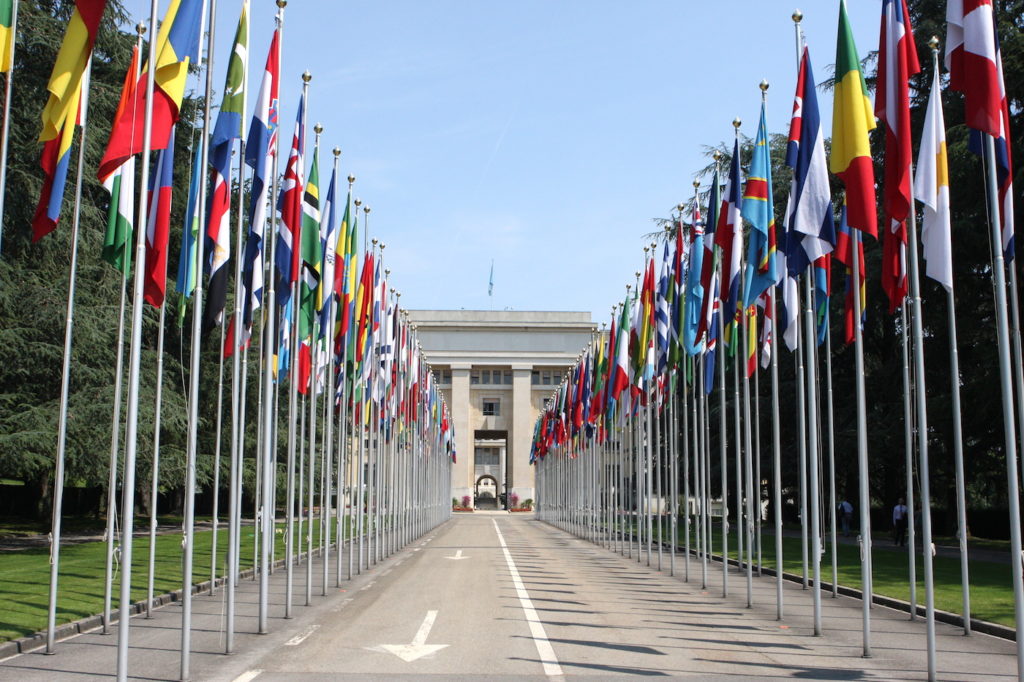Three years ago, in one of the many drab, windowless negotiation rooms of the United Nations Human Rights Council in Geneva, delegates were negotiating a resolution on the protection of the family. The room was divided along familiar lines—African and other developing nations supported the resolution, and the cohort of Western secular nations were outraged with the text.
At one point, a Western delegate took the microphone and demanded to know where the contentious language on the family had come from. She wanted to know how delegates could talk of the family as being the “natural and fundamental group unit of society,” and warned the room that her delegation could not possibly accept such terms.
The African chair of the negotiation gently pointed out that the language was taken verbatim from the Universal Declaration of Human Rights. At this point, the visibly embarrassed delegate retreated, and a few chuckles broke out around the room.
This short episode was not only amusing, but also illustrative.
Start your day with Public Discourse
Sign up and get our daily essays sent straight to your inbox.The Declaration was unanimously adopted in 1948 by the new UN General Assembly, consisting of fifty-eight countries of global geographic representation. The Declaration’s drafters appealed to the common intuition that every person, regardless of circumstances, challenges, privileges, or merits, has an inherent value, equal to that of all other persons. Respect for dignity became the keystone of all human rights.
All philosophical agreement, however, ended here. This lack of robust philosophical underpinnings has allowed anything and everything to attain the status of “human right” when couched in the language of dignity. Real human rights remain in a state of desperate neglect, and the complex human rights system born from the Declaration looks tired and toothless.
If the root of today’s human rights crisis can be traced back to the origins of the Declaration, so too can a possible solution. Although unanswered questions have resulted in a crisis of legitimacy, a return to the original understanding of the Declaration may still be able to reorient the work of human rights toward the true common good.
Agreement Without Foundation
Regardless of one’s political or spiritual affinities, the Declaration can be a challenging read for anyone with a strong set of beliefs. This is because it follows no one paradigm, abides by no single faith, and attempts unity among wildly disparate groups. By applying to everyone, it runs the risk of appealing to no one.
While many have criticized the Declaration for various reasons, conservatives are perhaps most vocal in their criticism today. With its layers of ambiguity and fluid anti-discrimination language, it is easy to see why the Declaration has been successfully captured by progressive forces to serve as the preeminent reference for controversial agendas that run contrary to the moral beliefs of many.
The Declaration attempts a universalist worldview that addresses the most important human rights questions of our time by, in large part, avoiding the underlying foundations to the answers. Herein lies both the main problem and the primary value of the Declaration. Why do we have human rights? From where do these rights come? What constitutes a fundamental human right? Such questions are tied to the very core of our existence and what it means to be human.
For religious believers, the source of our dignity lies squarely in the divine. Without a unifying religious vantage, however, it is hard to agree on a firm philosophical rationale for human rights.
Well aware of the difficulty of arriving at common ground on a deep existential level, the international architects of the Declaration chose to focus on matters of practical importance—namely, the urgency of avoiding the kind of cataclysmic large-scale war from which the world had just emerged. They therefore secured its foundations on a more tenuous, but workable, base comprising nothing more than a shared respect for human dignity. And so the Declaration commences by stating that “recognition of the inherent dignity and of the equal and inalienable rights of all members of the human family is the foundation of freedom, justice and peace in the world.” This would have to suffice, absent anything more profound on which they could agree.
The Hijacking of Human Rights
The lack of something more substantial to explain our inherent dignity has allowed for the many manipulations of the human rights framework that we see today. The dignity solution has resulted in a human rights hijacking, which, if left unchecked, could lead to the destruction of the entire project so carefully set in motion by the Declaration. The proliferation of newly invented “rights” in the name of dignity seems inevitable without a solid footing on which to stand.
It is not surprising that much of the fight over human rights concerns our core physical and existential needs. It is the very essence of the person that is up for debate. Freedom, understood as the absence of any limitations, represents the pinnacle of our modern ambitions, and anything that stands in the way is branded as an illegitimate shackling of the person and denial of human rights. “Sexual rights,” abortion, the elimination of parental rights, and radical sexuality education for children thus constitute the prevalent social issues in dispute at the UN today.
We can see this most clearly through the distortion of “the right to life” (Article 3). The UN Human Rights Committee recently adopted its official interpretation of what the “right to life” means. Their non-binding but highly influential interpretation supports medical practitioners’ euthanizing those who wish to “die with dignity.” It also states that countries must allow “safe access to abortion” in order to protect the right to life of women, even though international law offers nothing that implies a “right to abortion” and actually safeguards unborn life. UN human rights bodies have nevertheless pressured governments the world over to change laws on abortion, in violation of the International Conference on Population and Development (1994) Programme of Action, which states that abortion be determined at the level of national legislatures.
A similar story is unfolding with “LGBT rights.” Article 1 of the Declaration states, “All human beings are born free and equal in dignity and rights.” Although seemingly non-contentious, this statement is at the forefront of the controversial push for “LGBT rights” at the UN. Indeed, the UN’s primary multi-million-dollar LGBT campaign is entitled “Free and Equal,” with all manner of people pulled in to support this cause, including the late Mother Teresa—an ardent defender of the natural family.
A Declaration Built on Finding Consensus
The problem we see today is that anything can be misrepresented as a fundamental human right unless we either finally arrive at a shared philosophical understanding of the world or return to the drafters’ vision of a human rights project with a consensus-led base-line of agreement that is able to garner universal agreement. Given the impossibility of the former, it is high time we resume the Declaration’s back to basics approach. Until then, the project will continue to unravel as preference after preference is labeled a “human right” under the guise of dignity.
We therefore return to the origins of the Declaration in search of answers. Its success stemmed largely from the fact that it was so desperately needed—the horrors of global war propelled forward what would otherwise have been an impossible task. Participating countries showed an indisputable willingness to make it work, resorting to basic commonalities rather than lofty ambitions in order to come to agreement. Today, the fight over controversial agendas has subsumed both the sense of urgency and the desire for consensus that drove the Declaration to completion.
The battle of political and civil rights versus economic and social rights provides a striking example of the drafters’ commitment to solving impasses. The conservative stance, championed by the United States, was that attributing the status of a right to economic and social provisions such as good housing or leisure time imposed unwarranted obligations on states and ran the risk of weakening fundamental rights. The fear was that this would allow countries to pick and choose their favorite rights to promote. The USSR and its allies saw no problem with elevating economic and social rights to the same status as civil and political rights, and they wanted to impose clear obligations on states to guarantee these rights. This marked a serious divergence that easily could have put an end to the entire project.
As a result of skillful compromise, the full gamut of rights ultimately was included, but the economic and social were preceded by an accompanying paragraph (Article 22), which assuaged conservative concerns. By stating that they were to be realized “in accordance with the organization and resources of each State,” it limited the economic and social rights in such a way so as to facilitate conservative agreement. At the same time, the rights were labeled as “indispensable” to meet the demands of the USSR. While not perfect for either side, this approach reflected the intent of the drafters to achieve mutual agreement wherever possible, ultimately resulting in the successful adoption of the Declaration.
The success of the human rights project at the international level is contingent on our ability to return to the baseline—the protection of the core rights outlined in the Declaration. Countries are free to fight out issues of moral concern in their own legislatures and courts. This is the self-determination inherent in the principle of sovereignty on which the international order is based. At the international level, however, given that we still lack a shared understanding of the ultimate answers, the principle of consensus that worked seventy years ago is still the only way forward.
The Continued Relevance of the Declaration
As John Paul II observed, the greatest contribution of the Declaration is the “radical” and novel vision that disregard for human rights directly correlates with war. When human rights are violated, it “destroys the organic unity of the social order and it then affects the whole system of international relations.” This is the key contribution we must safeguard today. It is imperative that we uphold the Declaration as the definitive benchmark for international agreement on human rights. We must emphasize its actual language, while continuing to denounce illegitimate interpretations.
Despite its susceptibility to manipulation, the Declaration’s enormous contributions cannot be diminished. Its unequivocal affirmation of core rights such as freedom of religion and belief (both in private and “in community with others”) has held countries to a legal standard that previously did not exist. Although the Declaration is not a treaty, and therefore does not have teeth of its own, the international human rights instruments that flowed from it do have binding force. The Declaration can thus be credited for the many legal victories we see around the world today.
Conservatives cannot afford to abandon the institutions of power that seek to redefine human rights for the entire world. While the roar of false rights likely will not diminish, it is by standing firm in defense of fundamental freedoms that we can hope to see progress in the fight to end global human rights abuses. The temptation may be to forsake the international institutions and resist any appearance of assimilation with progressive agendas. The best solution, however, is to stay in the fight and proceed with the best and most truly universal resource at our disposal—the Declaration.













